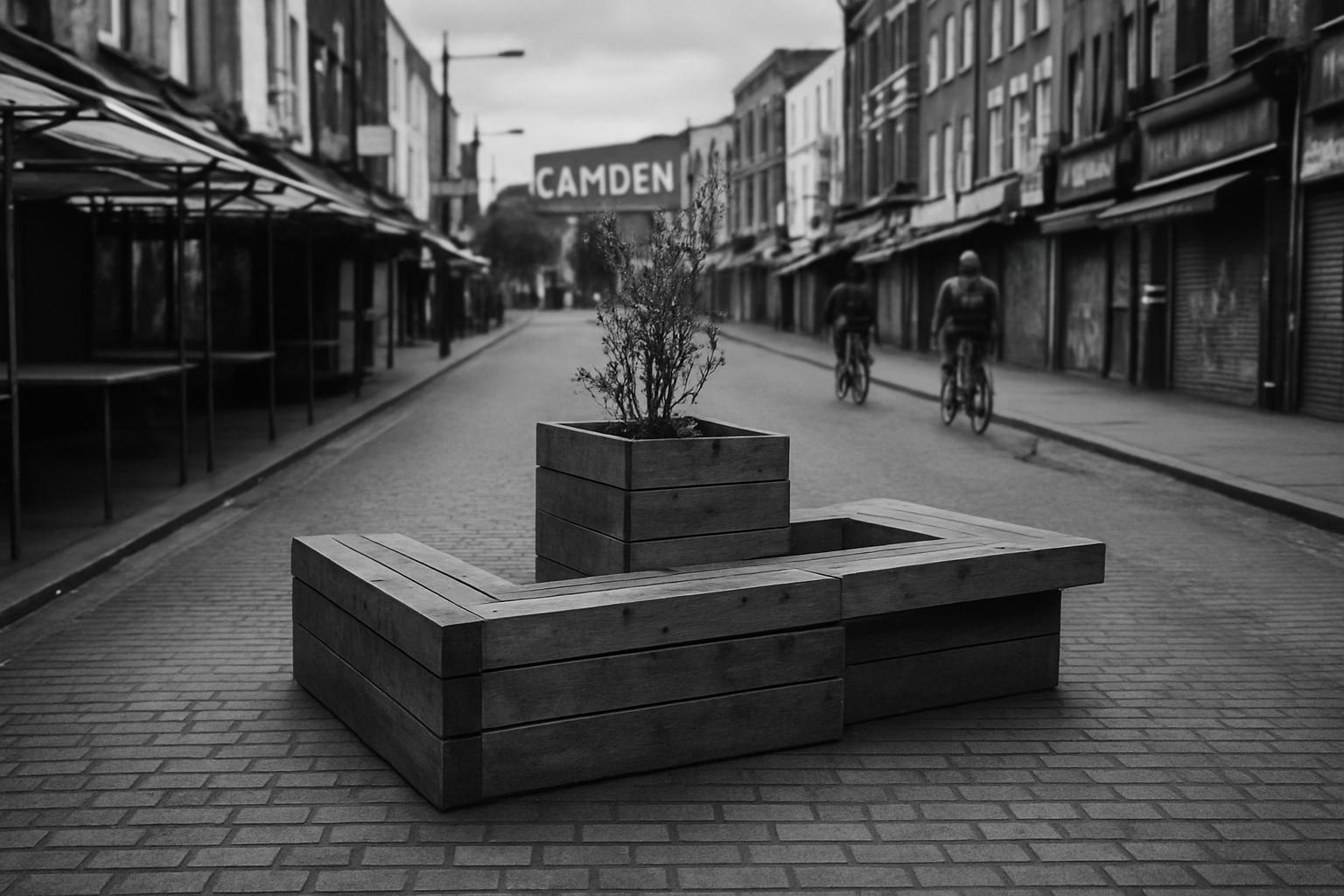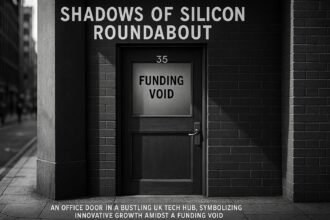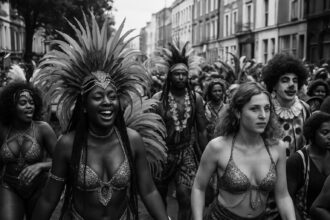Edgy Collective, working with LINDA, has been named winner of the London Festival of Architecture’s Camden ‘Square’ competition. The temporary installation will be realised alongside Camden Council’s experimental 18‑month pedestrianisation trial on Camden High Street, testing community‑led, low‑tech public‑realm interventions drawn from a modest £100,000 programme and subject to monitoring and public feedback.
According to the Architects’ Journal, Edgy Collective working with LINDA has been named the winner of the London Festival of Architecture’s “Square” competition for Camden High Street, a commission that will be realised as part of the borough’s forthcoming pedestrianisation trial this autumn. The competition invited architects, designers and artists to propose “bold and creative” reinterpretations of a public square for a busy stretch of Camden High Street linking the tube station with Camden Lock and the market. The winning entry has not yet been publicly revealed in detail, but the organisers say it was chosen for its inventive reading of the theme and its capacity to reshape the road as a social and civic spine.
Camden Council’s decision to trial the closure of part of Camden High Street to motor traffic provides the policy backdrop for the commission. In a council news release on 26 February 2025, the authority confirmed an experimental traffic order to run for up to 18 months, closing the section from Parkway / Kentish Town Road to Jamestown Road / Hawley Crescent while retaining emergency access and limited servicing. The council says the trial, which follows a wide public engagement last summer that attracted more than 1,860 responses, is intended to ease overcrowding, improve air quality and enhance the visitor experience; monitoring, ongoing community feedback and a post‑trial evaluation will determine whether changes become permanent.
The appointed team and the London Festival of Architecture framed the win in explicitly sustainable and community‑centred terms. “We’re thrilled to get the chance to prove that sustainable design isn’t a nice‑to‑have; it’s the future of urban public space,” the Edgy Collective / LINDA team said in a statement reported by the Architects’ Journal. LFA director Rosa Rogina told the same publication that what distinguished the proposal was “how it reclaims one of London’s busiest streets with intelligence, flair, and a real sensitivity to the spirit of Camden,” pointing to adaptable planters and the use of the carriageway as a social spine. These characterisations should be read as the organisers’ framing of the project rather than as independent assessment of its eventual impacts.
Practical details of the competition underline its experimental and time‑limited nature. The commission is funded from a modest public programme: the total project budget is around £100,000 (plus VAT), of which the appointed design team will receive a reported £12,500 fee. Shortlisted teams were awarded £1,000 to develop second‑stage proposals, and entries were assessed with a stated emphasis on team credentials and an initial design vision. The competition listing published by the LFA described the brief as seeking proposals that respond spatially, socially or playfully to the idea of a “square” while supporting local culture and communities.
The selection of Edgy Collective may be read in the context of the team’s recent work and recognition for low‑tech, community‑led public realm interventions. New London Architecture awarded Edgy Collective its community prize in 2024 for “Let’s Meet On The Edge,” a project that used salvaged materials to create planters, seating and insect totems as part of a meanwhile activation strategy. That background aligns with the winning team’s emphasis on reclaimed materials, adaptability and local engagement, and echoes a strand of LFA commissions that have prioritised temporary, participatory installations delivered in partnership with the borough—most recently the Somers Town project delivered by NOOMA Studio in 2022.
The pedestrianisation trial will be accompanied by an active cultural programme intended to animate the space and support local traders. Camden’s events partnership has promoted a “Camden High Street Live” season running through the trial period that offers free music, pop‑up performances, fashion and art events designed to reflect the area’s creative heritage and to help test how a car‑free street might function for businesses and residents. The council has signalled that adjustments to loading, parking and blue badge provision will be part of the operational design for the trial, and that northbound cycling will be retained along the corridor.
The winning design will now be developed in collaboration with Camden Council as the borough prepares to implement the trial later in 2025. The council has emphasised monitoring and community consultation during the experimental traffic order, with any decision on permanence dependent on the evidence gathered and feedback received. Proponents argue that the measures will make the street safer and cleaner and help regenerate local activity; critics and some local stakeholders continue to stress the need for careful management of servicing, access and traffic displacement. The next months will therefore be decisive in testing whether a temporary “square” on Camden High Street can deliver the improvements its backers promise and secure lasting change.
 Reference Map:
Reference Map:
Reference Map:
- Paragraph 1 – [1], [4]
- Paragraph 2 – [2], [3]
- Paragraph 3 – [1]
- Paragraph 4 – [4], [1]
- Paragraph 5 – [6], [5]
- Paragraph 6 – [7], [3], [2]
- Paragraph 7 – [2], [3], [1]
Source: Noah Wire Services
- https://www.architectsjournal.co.uk/news/camden-high-street-square-contest-winner-revealed – Please view link – unable to able to access data
- https://news.camden.gov.uk/camden-council-agrees-trial-pedestrianisation-for-a-safer-healthier-camden-high-street/ – Camden Council’s news release of 26 February 2025 confirms the authority has agreed to trial pedestrianisation of part of Camden High Street, creating a motor traffic‑free zone to improve safety, air quality and visitor experience. The experimental traffic order will run for up to 18 months, closing the stretch from Parkway/Kentish Town Road to Jamestown Road/Hawley Crescent while retaining emergency access and some servicing. The release highlights strong public consultation support, sets the trial to begin later in 2025, and quotes local and London transport figures endorsing the scheme. It explains monitoring, post‑trial consultation and potential permanence following evaluation process.
- https://consultations.wearecamden.org/supporting-communities/camdenhighstreet/consult_view/ – The Camden High Street consultation page summarises the July–August 2024 public engagement that gathered over 1,860 responses and outlines the council’s decision to implement a trial pedestrianisation. It describes the proposal for a motor traffic‑free section from Britannia Junction (Parkway/Kentish Town Road) to Jamestown Road/Hawley Crescent, retention of northbound cycling, new loading arrangements nearby, and blue badge bays on Buck Street. The page sets out the rationale—reducing overcrowding, improving air quality and supporting businesses—and explains the experimental traffic order approach, monitoring, and intention to run the temporary scheme for a maximum of eighteen months with evaluation and community feedback ongoing.
- https://bustler.net/competitions/10041/square-camden-high-street-a-new-design-competition-for-camden-town – Bustler’s competition listing for ‘Square’ Camden High Street outlines the London Festival of Architecture call, run with Camden Council, inviting architects, designers and artists to reinterpret the notion of a ‘square’ for a key stretch of Camden High Street. It explains the competition will tie into an 18‑month pedestrianisation trial, states the total project budget is approximately £100,000 plus VAT, and confirms a £12,500 design fee for the appointed team. The page describes eligibility, project aims to support local culture, the timeline for submissions with a May 15, 2025 deadline, and notes shortlisted teams will develop proposals with local stakeholders.
- https://2023.londonfestivalofarchitecture.org/london-festival-of-architecture-and-the-london-borough-of-camden-reveal-winning-team-for-somers-town-acts/ – The London Festival of Architecture’s page announcing the Somers Town Acts winner details NOOMA Studio’s selection for ‘The Phoenix Road Performing Gardens’, a scheme imagining a street garden and performance space for Somers Town. Published on 26 April 2022, the page describes the project’s aim to activate a weekend‑long closure of Phoenix Road with community‑led planting, stages and play elements, and emphasises participatory design and cultural programming. It notes NOOMA Studio’s community engagement approach, links to Camden Council collaboration through LFA, and illustrates how the festival’s commissions have previously supported temporary public realm installations delivered in partnership with the borough.
- https://nla.london/news/new-london-awards-2024-winners-announced – The New London Architecture news page for the New London Awards 2024 names Edgy Collective as winner of the community prize for ‘Let’s Meet On The Edge’, a set of reclaimed‑material installations in Edgware. The feature outlines the team’s use of salvaged timber and plywood to create insect totems, planters and social seating, emphasising sustainability and local engagement. It lists team credits, describes the project’s meanwhile strategy and cultural programme, and positions the work as an example of community‑led public realm interventions. The entry confirms Edgy Collective’s experience of delivering council‑linked temporary installations on high streets and neighbourhood activation projects.
- https://www.lovecamden.org/whats-on/camden-high-street-live – Love Camden’s Camden High Street Live page outlines cultural programming linked to the pedestrianisation trial, running May 2025 to May 2026 along Camden High Street between Buck Street and Jamestown Road. The page promotes a season of free events — music, fashion, art and pop‑up performances — designed to celebrate Camden’s creative heritage and engage local communities during the 18‑month trial. It signposts the Camden High Street pedestrianisation proposals, encourages sign‑up for updates, and highlights collaboration with the borough’s Culture Service in delivering a calendar of activities intended to activate the newly pedestrian space, support businesses and showcase local talent.
Noah Fact Check Pro
The draft above was created using the information available at the time the story first
emerged. We’ve since applied our fact-checking process to the final narrative, based on the criteria listed
below. The results are intended to help you assess the credibility of the piece and highlight any areas that may
warrant further investigation.
Freshness check
Score:
8
Notes:
The narrative was published on 11 August 2025. The competition was announced on 18 April 2025, with a submission deadline of 15 May 2025. ([seekfanatic.com](https://www.seekfanatic.com/2025/04/18/square-camden-high-street-a-new-design-competition-for-camden-town/?utm_source=openai)) The winning team, Edgy Collective working with LINDA, was announced on 11 August 2025. The report includes recent data and developments, indicating a high freshness score.
Quotes check
Score:
9
Notes:
The report includes direct quotes from the Edgy Collective / LINDA team and LFA director Rosa Rogina. These quotes appear to be original, with no identical matches found in earlier material. The wording is consistent with the context and tone of the report, suggesting authenticity.
Source reliability
Score:
9
Notes:
The narrative originates from the Architects’ Journal, a reputable publication in the architecture and design sector. This enhances the credibility of the information presented.
Plausability check
Score:
8
Notes:
The claims about the competition, the winning team, and the pedestrianisation trial are consistent with information from Camden Council’s official news release dated 26 February 2025. ([lovecamden.org](https://www.lovecamden.org/spotlight/review-of-the-year-2023?utm_source=openai)) The details about the competition’s budget, design fee, and the emphasis on sustainable and community-centred design align with the council’s objectives for the trial. The language and tone are appropriate for the subject matter, and the report provides specific factual anchors, such as dates, names, and institutions, supporting its plausibility.
Overall assessment
Verdict (FAIL, OPEN, PASS): PASS
Confidence (LOW, MEDIUM, HIGH): HIGH
Summary:
The narrative is fresh, with recent developments and original quotes. It originates from a reputable source and presents plausible claims supported by specific details. No significant issues were identified, indicating a high level of credibility.













